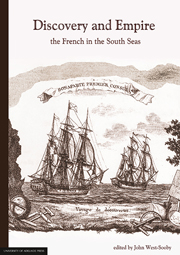Book contents
- Frontmatter
- Contents
- List of Figures
- List of Contributors
- Acknowledgements
- Introduction
- Note on the Second Frank Horner Lecture
- 1 The Globe Encompassed: France and Pacific Convergences in the Age of the Enlightenment
- 2 The Abbé Paulmier's Mémoires and Early French Voyages in Search of Terra Australis
- 3 The Acquisitive Eye? French Observations in the Pacific from Bougainville to Baudin
- 4 Discovering the Savage Senses: French and British Explorers' Encounters with Aboriginal People
- 5 A Case of Peripheral Vision: Early Spanish and French Perceptions of the British Colony at Port Jackson
- 6 New Creatures Made Known: Some Animal Histories of the Baudin Expedition
- 7 “Primitive race”, “pure race”, “brown race”, “every race”: Louis Freycinet's Understanding of Human Difference in Oceania
- 8 Imperial Eyes on the Pacific Prize: French Visions of a Perfect Penal Colony in the South Seas
5 - A Case of Peripheral Vision: Early Spanish and French Perceptions of the British Colony at Port Jackson
Published online by Cambridge University Press: 05 April 2014
- Frontmatter
- Contents
- List of Figures
- List of Contributors
- Acknowledgements
- Introduction
- Note on the Second Frank Horner Lecture
- 1 The Globe Encompassed: France and Pacific Convergences in the Age of the Enlightenment
- 2 The Abbé Paulmier's Mémoires and Early French Voyages in Search of Terra Australis
- 3 The Acquisitive Eye? French Observations in the Pacific from Bougainville to Baudin
- 4 Discovering the Savage Senses: French and British Explorers' Encounters with Aboriginal People
- 5 A Case of Peripheral Vision: Early Spanish and French Perceptions of the British Colony at Port Jackson
- 6 New Creatures Made Known: Some Animal Histories of the Baudin Expedition
- 7 “Primitive race”, “pure race”, “brown race”, “every race”: Louis Freycinet's Understanding of Human Difference in Oceania
- 8 Imperial Eyes on the Pacific Prize: French Visions of a Perfect Penal Colony in the South Seas
Summary
During the second half of the eighteenth century, the vast expanses of the Pacific Ocean became the distant stage on which various European powers played out their struggle for dominion. The Spanish had been masters of this region of the globe since Ferdinand Magellan's memorable crossing at the beginning of the sixteenth century. A succession of Spanish ships followed in Magellan's wake, discovering in the process a number of the Pacific Ocean's island groups and, most importantly for Spain, paving the way for what would prove to be an enduring and lucrative trade route between Mexico in the east and the Philippines in the west. The renowned Manila galleons that plied this route provided Spain with considerable economic benefits. They also gave a degree of substance to the 1494 Treaty of Tordesillas and the 1529 Agreement of Saragossa that had granted Spain putative sovereignty over the Pacific. For well over two hundred years, then, and notwithstanding the occasional foray into this region by privateers or state-sponsored vessels of other nations, the Pacific Ocean remained essentially the preserve of the Spanish.
As far as the rest of Europe was concerned, this great ocean, representing roughly one third of the earth's surface, was afforded little more than peripheral status during this extended period. That situation changed dramatically over the course of the eighteenth century, as other European nations, spurred on by a variety of often intertwined motives (commercial, strategic, scientific…), began to venture into the Pacific.
- Type
- Chapter
- Information
- Discovery and EmpireThe French in the South Seas, pp. 141 - 170Publisher: The University of Adelaide PressPrint publication year: 2013

